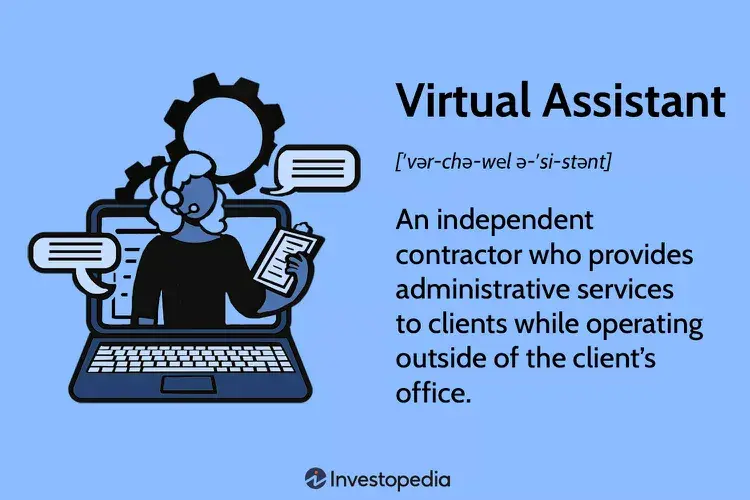Introduction
As the digital world expands and technology advances, a universe of remote work opportunities have emerged, including the lucrative and flexible option of becoming a virtual assistant. Embrace the freedom, adaptability, and global allure of this career as the demand for virtual assistants soars. This beginner’s guide will help you navigate the virtual assistant role, key skills, and steps to jumpstart your virtual assistant adventure.

A. Understanding the Virtual Assistant
Virtual assistants are adept professionals providing remote administrative, technical, or creative support to businesses, entrepreneurs, or busy individuals. VAs use cutting-edge technology and tools to work from home or any location with a reliable internet connection. This remote setup means significant savings and enhanced flexibility for both VAs and their clients
A virtual assistant’s tasks can vary greatly based on client needs and the VA’s expertise. Common responsibilities include:
1. Administrative tasks:
Virtual assistants (VAs) can efficiently manage various administrative tasks. These can range from scheduling appointments and arranging travel itineraries to handling emails and responding to customer inquiries. They can also manage calendars, organize meetings, take minutes, and provide other secretarial services.
2. Bookkeeping:
VAs can support your business financial operations by handling bookkeeping tasks. These could include managing invoices, tracking expenses, reconciling bank statements, and preparing financial reports. They may also assist with payroll processing and financial forecasting.
3. Data entry:
VAs can input data into numerous systems, such as customer relationship management (CRM) platforms like Salesforce, accounting software like QuickBooks, and marketing databases. They ensure data accuracy, perform regular data cleaning, and generate insightful reports.
4. Customer service:
VAs can offer robust customer service support. They can handle customer inquiries, resolve complaints, process returns and refunds, and provide information about products and services. They may use phone, email, or live chat to interact with customers, aiming to enhance customer satisfaction and loyalty.
5. Marketing:
VAs can assist with various marketing tasks, including social media management on platforms like Facebook, Instagram, LinkedIn, and Twitter. They can also write engaging blog posts, develop and manage email marketing campaigns using tools like MailChimp, and help with search engine optimization (SEO) strategies.
6. Web design and development:
VAs with technical skills can assist in web design and development. They can create and manage websites using platforms like WordPress, develop e-commerce platforms using tools like Shopify, and update and optimize web content for SEO.
7. Graphic design:
VAs can provide graphic design services, which may involve creating company logos, designing marketing materials, developing presentations, and editing images. They may use software like Adobe Photoshop and Illustrator to create visually appealing designs.
8. Writing:
VAs can assist with writing tasks, including creating informative articles, engaging blog posts, persuasive marketing materials, and compelling web content. They can tailor their writing style to match your brand voice and audience preferences.
9. Research:
VAs can perform a wide range of research tasks, from gathering market data and analyzing competitors to conducting customer surveys and writing insightful reports. They can leverage various research tools and databases to provide accurate and valuable information.
10. Translation:
Multilingual VAs can provide translation services, which may involve translating documents, websites, and marketing materials from one language to another. This can help businesses expand their reach to non-English speaking markets.

B. Initiating Your Journey: Assess Your Skills and Establish a Niche
1. Recognize your strengths:
Begin by assessing your prowess in communication, organization, time management, and technical expertise. Reflect on your previous work experience and education to determine your unique offerings. For example, if you have a background in marketing, you might excel at social media management or content creation.
- Select a niche: Some VAs specialize in particular industries or services rather than general admin support. By choosing a niche, you can market yourself more effectively and attract clients who appreciate your expertise. Consider these popular niches:
- E-commerce: Assisting online retailers with inventory management, customer service, and order processing.
- Real estate: Supporting agents in managing listings, coordinating showings, and handling paperwork.
- Legal: Helping law firms with transcription, document preparation, and legal research.
- Health and wellness: Supporting wellness coaches, therapists, or nutritionists with scheduling, content creation, and social media management.
- Creative services: Assisting clients with graphic design, video editing, or copywriting.
2. Refine your skills:
Once you’ve pinpointed your area of expertise, it’s crucial to continually refine your skills and stay abreast of industry trends. The ability to provide exemplary services can be cultivated by pursuing online learning opportunities, participating in workshops, and obtaining relevant certifications. There are numerous online educational platforms such as Coursera, LinkedIn Learning, and Skillshare that offer an extensive selection of courses, enabling you to broaden your existing capabilities and acquire new ones.

3. Network with other virtual assistants:
Engage with other VAs in your niche through social media, online forums, or local meetups to share resources, experiences, and advice. Building connections with other professionals can help you gain insights and may even lead to referrals.

With a solid understanding of your abilities and a well-defined niche, you’ll be better prepared to market your services and launch a successful virtual assistant career.
C. Set Up a Business and Build a Portfolio
Ready to kick off your virtual assistant business? Here’s a step-by-step guide to setting up shop and creating a portfolio that turns heads:
1. Create a stunning website:
Consider your website as your online hub where you can show off your skills, services, and glowing testimonials. Pick an intuitive website builder such as Wix, Squarespace, or WordPress to craft a visually appealing site packed with essentials: contact details, a brief introduction, and an outline of your offerings.
2. Optimize for mobile devices:
Ensure your website looks fabulous on mobile phones and tablets, as many people rely on their smartphones for browsing. A responsive design that adapts to different screen sizes guarantees a smooth experience for all visitors.
3. Embrace social media:
Leverage platforms like Facebook, LinkedIn, and Instagram to connect with potential clients and fellow virtual assistants. Keep your profiles fresh with relevant updates, share useful content, and engage with your audience to showcase your expertise.
4. Build a portfolio that wows:
A captivating portfolio is your ticket to landing clients and showcasing your skills. Include project samples, case studies, and any relevant certifications. If you’re new to the VA scene and don’t have any client work to share, try doing mock projects or offer your services to friends, family, or non-profits to gain experience and bulk up your portfolio.
5. Create a standout brand:
Develop a consistent brand identity that embodies your business and services. Your business name, logo, color scheme, and tone of voice all contribute to making a lasting impression on potential clients.
6. Pinpoint your target market:
Zero in on your ideal clients and the industries you want to serve. By understanding their unique needs and challenges, you can tailor your services and marketing efforts to address their specific requirements effectively.
7. Get your business on the books:
You might need to register your virtual assistant business depending on where you reside and local laws. Make sure you are in compliance by doing your research on local laws and seeking advice from a legal or financial expert. By registering your company, you may receive financial benefits as well as an increase in credibility.
8. Map out a marketing strategy:
Draw clients in and grow your business by deploying a marketing strategy that combines online and offline tactics. Think about blogging, social media marketing, email marketing, networking events, and conferences as avenues for promotion.
By investing time and effort in setting up your business and crafting a solid portfolio, you’ll be poised to attract clients and make a name for yourself as a top-notch virtual assistant.

If you’re contemplating hiring a virtual assistant, follow these steps:
D. How to Hire a Virtual Assistant
Hiring a virtual assistant (VA) can be a game-changer for your business which provides critical support and freeing you to focus on strategic matters. Here are the important steps to follow when hiring a VA:
1. Define Your Needs:
Start by clearly identifying what you need from a VA. Is it administrative support, technical expertise, or creative work? Create a list of tasks you need assistance with. Your needs should also factor in your budget constraints and the time frame for task completion.
2. Search for Candidates:
Having clearly outlined your specific needs, the subsequent course of action entails searching for proficient virtual assistants. A multitude of online arenas can facilitate your quest for prospective candidates. This includes platforms like Upwork, Fiverr, Freelancer.com, or even professional networking sites like LinkedIn. Each of these online venues caters to a distinct set of competencies, thereby enabling you to select based on the skillset required for your tasks.
3. Evaluate Profiles:
Once you have identified potential candidates, review their profiles thoroughly. Check their ratings, feedback from previous clients, portfolio of work, and overall experience. This evaluation will help you shortlist the candidates who seem most fitting for your needs.
4. Conduct Interviews:
Once you have a list of promising virtual assistant candidates, arrange meetings with them. These meetings can conveniently take place using digital meeting platforms like Zoom or Google Meet. The meeting is a perfect opportunity to inquire about their professional background, expertise, and their approach to dealing with particular assignments. Evaluating these factors not only helps you gauge their proficiency and how well they align with your requirements, but also offers a glimpse into their communication prowess and ability to devise solutions.

5. Run a Trial Task:
If possible, assign a trial task to the top candidates. This will give you a real-world idea of how they work and how well they can meet your specific requirements. This can be a paid task and doesn’t necessarily need to be very complex, just enough to showcase their skills.
6. Make an Offer:
Once you have identified the VA that best suits your needs, extend a job offer. Be clear about the terms of engagement including work hours, payment terms, and task expectations. Negotiate these terms as necessary until both parties are in agreement.
7. Onboard Your Virtual Assistant:
Once the VA has accepted your offer, it’s time to integrate them into your work processes. Provide them with all the necessary access to tools and information. Make sure to communicate your expectations clearly and set up a reliable system of communication for ongoing tasks and feedback.
8. Monitor Performance and Provide Feedback:
As your new VA starts working, monitor their performance closely, especially in the beginning. Providing feedback regularly helps your VA align better with your work style and expectations.
Hiring a virtual assistant can save you time and help you be more productive. Remember, the key to a successful VA-client relationship is clear communication and setting appropriate expectations.

E. legal requirements for virtual assistants
Understanding the regulatory landscape and ethical norms for virtual assistants:
1. Business Permits:
Depending on their location, virtual assistants might need to acquire a permit or license to operate their business. The rules can differ widely from one location to another, making it important to consult local authorities or their online resources for specific guidance.
2. Service Contract:
A service contract is a binding document between a virtual assistant and the client. This essential document should spell out all the provisions related to the services, including the work’s nature, associated fees, payment modalities, and ways to manage disagreements, if any. You can find contract templates on websites like Rocket Lawyer or LegalZoom, but consider consulting with a lawyer to ensure all your bases are covered.
3. Liability Release:
A liability release form acts as a safeguard for virtual assistants, providing a layer of protection against unexpected incidents like personal injuries or property damage that could occur during service delivery.
4. Insurance Coverage:
Insurance is often crucial for virtual assistants, depending on the tasks they undertake. Insurance policies like liability insurance or workers’ compensation insurance can cover potential risks tied to their work.
5. Tax Obligations:
As self-employed professionals, virtual assistants must address their tax responsibilities. The tax obligations can vary depending on the business structure of the virtual assistant, and it is always wise to seek advice from a tax consultant to understand these requirements accurately. Depending on your location and the nature of your services. Websites like IRS for US or HMRC for UK can offer guidance.
Moreover, virtual assistants should adhere to a few ethical guidelines:
i. Secrecy:
It’s vital for virtual assistants to maintain stringent confidentiality, safeguarding all client data, whether communicated orally, in writing, or electronically. You should familiarize yourself with data protection laws such as the General Data Protection Regulation (GDPR) in Europe or the California Consumer Privacy Act (CCPA) in the US.
ii. Professional Decorum:
Professionalism is a must for virtual assistants. This includes being on time, being responsive, being reliable, and showing respect for the client’s time and resources.
iii. Legal Adherence:
Virtual assistants need to follow all relevant laws and regulations, particularly those related to privacy, data protection, and intellectual property rights.
Complying with these regulatory and ethical standards helps protect virtual assistants while also fostering trust with clients.
For additional help, here are some noteworthy resources:
- International Association of Virtual Assistants (IADVA): A globally recognized professional body for virtual assistants, providing a wide range of resources and support, encompassing legal and ethical guidelines.
- Virtual Assistants Association of America (VAAA): Another significant professional organization that offers comprehensive resources and assistance to virtual assistants, focusing on legal aspects and ethical norms.
- US Small Business Administration (SBA): A governmental institution offering various supports and resources to small businesses, with a dedicated section addressing legal and regulatory compliance for small ventures.

F. Frequently Asked Questions about Virtual Assistant

What skills are needed to be a virtual assistant?
Becoming a virtual assistant requires a diverse skill set that allows them to handle various tasks efficiently. These skills range from technical and administrative to creative and interpersonal. Here are some essential skills:
i. Managerial Abilities: This category involves skills such as proficiency in managing calendars using tools like Google Calendar, scheduling appointments, planning travel itineraries, overseeing emails, and carrying out various other administrative responsibilities that might be too time-consuming for clients.
ii. Technical Proficiencies: It’s important to be familiar with office software suites, such as Microsoft Office or Google Workspace. Additional technical abilities can encompass managing social media platforms, crafting and maintaining websites, understanding Search Engine Optimization (SEO), or displaying aptitude in data entry and handling.
iii. Interpersonal Communication: Outstanding written and verbal communication skills are indispensable. Given the role of a Virtual Assistant as a conduit between clients, team members, and other involved parties, the ability to articulate information clearly and effectively is paramount.
iv. Time Management: Since virtual assistants often work with multiple clients or have various tasks, excellent time management skills are crucial. They should be adept at prioritizing tasks, meeting deadlines, and managing their schedule efficiently.
v. Problem-Solving Skills: Virtual assistants often need to handle unexpected issues independently. Thus, the ability to troubleshoot problems and find solutions is an essential skill.
vi. Organizational Skills: The ability to keep work organized and maintain a good system for tracking tasks and deadlines is essential. This includes document management, filing, and keeping digital workspaces tidy.
vii. Attention to Detail: VAs need to produce accurate and high-quality work, so a keen eye for detail is important.
viii. Dependability: Clients need to know they can rely on their VA to complete tasks on time and maintain confidentiality.
ix. Creativity: For those VAs who provide creative services like content creation, graphic design, or social media management, having a creative eye can be very beneficial.
x. Flexibility: The nature of a Virtual Assistant’s role often demands versatility in managing a multitude of tasks, and swiftly mastering new technological tools while accommodating varied working methods is of paramount importance.
In conclusion, a significant aspect of being a Virtual Assistant is the necessity for persistent skill enhancement in line with emerging tools and technologies. This underscores the value of enduring self-education in this profession.
What’s the earning potential for a virtual assistant?
The income that virtual assistants can make can fluctuate based on several elements such as their professional background, competencies, and geographical location. To provide a ballpark figure, survey data from Upwork suggests that the median yearly income for a virtual assistant residing in the United States is roughly $45,000.
What do virtual assistants charge per hour?
Consider factors like experience, skillset, task complexity, and industry norms when setting rates. You can charge an hourly rate, fixed price per project, or monthly retainer. Research rates of similar VAs for pricing insights.
What is Amazon virtual assistant?
Alexa, a voice-activated assistant developed by Amazon, leverages the power of artificial intelligence to carry out a myriad of functions and furnish users with valuable information. Designed primarily to work seamlessly with Amazon’s Echo line of smart speakers, Alexa is also compatible with an extensive range of smart home equipment and apps developed by other companies.
Is virtual assistant an easy job?
The perception of whether being a virtual assistant (VA) is an easy job can greatly depend on one’s perspective, skills, and previous experiences. While working as a VA does have its benefits, like the flexibility of working from home and often setting your own hours, it also comes with its own set of challenges.
How do I find clients as a virtual assistant?
Finding clients as a virtual assistant involves several strategies:
i. Online Platforms: Register on freelance platforms like Upwork, Fiverr, and Freelancer.com, where you can bid for projects or be discovered by potential clients.
ii. Building Connections: Capitalize on your current relationships and connections. Participate in relevant industry events, virtual or physical, as these provide opportunities to meet potential clients.
iii. Utilizing Social Media: Harness the power of social platforms like LinkedIn, Facebook, and Twitter to promote your services and establish connections with potential clients.
iv. Personal Website: Develop a professional digital persona by creating your own website. This website should showcase your work samples, skills, client testimonials, and ways to get in touch with you.
vi. Proactive Engagement: Actively identify companies that could gain from your services and make direct contact with them through email or social media platforms.
Which tools and software should a virtual assistant know?
The role of a virtual assistant necessitates the use of numerous applications and programs. While the specific software needed can vary depending on the tasks assigned by individual clients, some tools are frequently utilized by the majority of virtual assistants:
i. Productivity Software: It’s crucial to have a good understanding of either the Microsoft Office (Word, Excel, PowerPoint) or Google Workspace (Docs, Sheets, Slides) is fundamental for word processing, data handling, and presentations.
ii. Email Management: Tools like Outlook or Gmail, including understanding how to handle filters, folders, and other organizational features.
iii. Project Management Tools: Familiarity with tools such as
Trello, Asana, or Basecamp can help manage tasks and keep projects on track.
iv. Communication Tools: Virtual assistants often use tools like Slack, Zoom, Microsoft Teams, or Google Meet for internal communication and virtual meetings.
v. File Sharing: Knowing how to use cloud storage systems like Google Drive, Dropbox, or OneDrive for storing and sharing files is important.
vi. Social Media Management: Tools like Hootsuite or Buffer are often used for scheduling social media posts and managing accounts.
vii. Time Tracking Tools: If you’re billing by the hour, tools like Toggl or Harvest can be useful for keeping track of your time.
viii. CRM Software: Depending on your client’s needs, you may need to be familiar with Customer Relationship Management software like Salesforce or HubSpot.
G. Final Thoughts:
The realm of virtual assistance is teeming with possibilities for anyone seeking a work-from-home lifestyle and online income. By pinpointing your talents, finding your niche, and promoting yourself efficiently, you can forge a prosperous path as a virtual assistant. Make the most of the resources in this guide, and you'll be on track to achieve financial freedom and a gratifying online profession.
Also Read >>> 10 Credit Card Perks You Didn’t Know You Had

